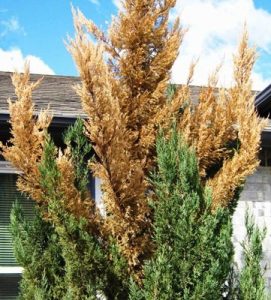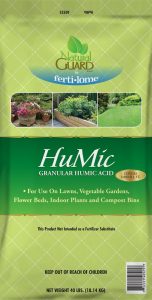by Ken Lain, the mountain Gardener

You’ve done your homework by assessing your yard and using appropriate information to choose just the right trees for your landscape. You’ve had Watters Garden Center plant them in the proper way, and have worked hard to water, prune, and fertilize each one. However, just like the gardeners who care for them, trees can become sick. Here are some things to look for when assessing whether or not a tree is healthy:
Only One Central Leader (For Most Trees) – Most landscape trees should be pruned to have only one central leader. This adds strength and stability to the tree’s structure and creates a straight appearance. If there is more than one leader, it may eventually cause the tree to split in two.
Exceptions include:
- Fruit trees: peach, nectarine, cherry, plum, and others.
- Trees that naturally grow with several trunks, each branch coming from the base, yet having only one central leader. Some examples are Desert Willow, Flame Maple, and Chase trees.
- Topiary and bonsai shaped forms, including espaliered trees
Evidence of Yearly Growth – Trees produce new growth yearly on their trunks and branches. To see how much growth has occurred in the past year, check the distance between this year’s buds and last year’s. The average annual increases vary by tree species, so learn what increases you should expect. A tree with no signs of yearly growth may be in trouble.
Trunks with Peeling Bark – Except for certain trees like birch, eucalyptus, maple, and paperbark maples, a tree’s bark should not be loose or peeling away from the wood underneath.
NO fungi should be growing on the trunk. Be careful when using garden equipment around trees, as damage to the bark can leave an open wound where insects and diseases can attack. There should be no large cracks or holes in the bark. Observe pinholes in the bark of pine trees, the sure tale sign of bark beetle attacks.
Bare Patches and Dead branches are BAD – If you have an evergreen tree, watch for sections without leaves year-round. Deciduous trees should have their leaves by this time of year. If not, some common causes of bare patches include:Bare Patches and Dead branches are BAD – If you have an evergreen tree, watch for sections without leaves year-round. Deciduous trees should have their leaves by this time of year. If not, some common causes of bare patches include:
- Nutrients and water not reaching those branches, or that section of the tree.
- Animals, like deer and porcupines, eating the leaves.
- Improper pruning practices.
- Pesticide or weed killer damage.
- Insects and diseases.
Suitable Leaf Color, Shape, and Size – Leaves are useful indicators of poor tree health. Make sure leaves are the right color for the season. Unless the tree naturally has yellow or variegated leaves, be especially wary if they turn yellow. They should not be stunted or irregularly-shaped. These are signs of nutrient deficiencies, insect damage, watering problems, pesticide damage, and/or diseases.
Bad Insects or Diseases – Other causes of poor tree health include insects and diseases. Some warning signs to look for are:
- Insects visible on the tree.
- Lack of fruit or flowers.
- Distortions in leaf size, color, or shape.
- Holes in bark, branches, or leaves.
- Growths or nodules on the limbs.
- Oozing sap – especially on elms and cottonwoods.
- Decreasing growth rate
- Wilting
 If unsure how to treat a diseased tree please visit Watters Garden Center right away for potential cures. Don’t wait. Summer is when tree diseases and insect populations grow rapidly, and more readily kill trees.
If unsure how to treat a diseased tree please visit Watters Garden Center right away for potential cures. Don’t wait. Summer is when tree diseases and insect populations grow rapidly, and more readily kill trees.
All trees benefit from feeding with Watters 7-4-4 All Purpose Plant Food in July, but if you suspect you have a sick tree it is essential to also spread Natural Guards’ ‘HuMic’ under the dripline.
All-Purpose Plant Food will increase your trees’ green color, branch sturdiness, and leaf thickness. This summer feeding also sets the stage for better color when Autumn comes around.
HuMic is a granular product to spread at the base of trees. It acts much like an antibiotic for plants. It stimulates deeper root growth and plant hardiness as trees interact with this nutritious additive.
Make sure to apply both these treatments before the Monsoon rains arrive.
Free Gardening Classes each week at Watters Garden Center.
June 28 @ 3:30 pm – Animal Resistant Plants – What’s Eatin’ Your Garden?
Yes, there are plants that actually taste bad to the critters, but still, look gorgeous in the garden! This class is crucial for gardeners trying to enjoy our beautiful outdoor environment and abundant wildlife, but not have their landscape become lunch. Learn which plants deer, javelina, and rabbits usually shy away from, and where they will best grow in your garden.
July 6, Saturday @ 9:30 am “Creating Containers that Bloom like Crazy!” The right container with the right plants can bring a space in the landscape from just “so-so” to knock-out “stunning”. Watters Garden Center has been creating container designs for decades. Our 3-step program can help you bring an eye-catching floral style into your landscape, porch, patio.
July 12, Friday @ 3:30 pm “ Planting Juicier Fruits, Grapes & Berries” We will have experts on hand to share the best-producing raspberry bushes, a blackberry bush that produces HUGE berries, and more table grapes, gooseberries, currants, elderberries, etc. Learn how to create a garden harvest of big, juicy fruits.
Until next issue, I’ll be helping local gardeners diagnose and cure their trees here at Watters Garden Center.
Ken can be found throughout the week at Watters Garden Center, 1815 W. Iron Springs Rd in Prescott, or contacted through his web site at WattersGardenCenter.com or FB.com/WattersGardenCenter.

